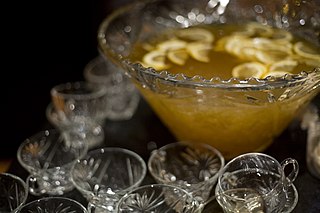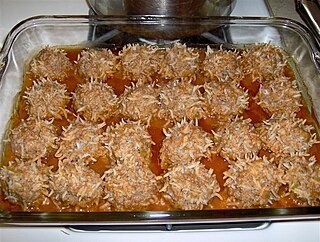 W
WButtermilk pie is a pie in American cuisine. Associated with the cuisine of the Southern United States, it is one of the desperation pies, made using simple, staple ingredients.
 W
WChatham Artillery Punch is a potent punch containing rum, whisky, brandy, and Champagne. It also contains lemons and sugar. Named after the Savannah regiment, it is well-known in its the city of Savannah, Georgia.
 W
WChicken à la King is a dish consisting of diced chicken in a cream sauce, often with sherry, mushrooms, and vegetables, generally served over rice, noodles, or bread. It is also often served in a vol-au-vent or pastry case.
 W
WDesperation pies are pies in American cuisine made using staple ingredients like butter, sugar, eggs and flour, and making use of other ingredients that cooks had on hand to substitute for ingredients that were out of season or too expensive. These pies were more common before refrigeration and canned pie fillings, and during times of hardship like the Great Depression and rationing of World War II.
 W
WDunkaroos are a snack food from Betty Crocker, first launched in 1990. It consists of a snack-sized package containing cookies and frosting; as the name implies, the cookies are meant to be dunked into the frosting before eating. Individual snack packages contain about ten small cookies and one cubic inch of frosting. The cookies are made in a variety of shapes, including a circle with an uppercase "D" in the center, feet, the mascot in different poses, and a hot air balloon.
 W
WAn egg cream is a cold beverage consisting of milk, carbonated water, and flavored syrup. Despite the name, the drink contains neither eggs nor cream.
 W
WFish House Punch is a strong, rum-based punch containing rum, cognac, and peach brandy. The drink is typically served over an ice block in a punch bowl and garnished with lemon slices.
 W
WA floating island or île flottante is a dessert consisting of meringue floating on crème anglaise. The meringue is prepared from whipped egg whites, sugar, and vanilla extract and baked in a bain-marie. The crème anglaise is prepared with the egg yolks, vanilla, and hot milk, briefly cooked.
 W
WKaboom was the name of a vitamin-fortified, circus-themed breakfast cereal produced by General Mills, which contained oat cereal bits shaped like smiling clown faces and marshmallow bears, lions, elephants, and stars. Its mascot was a smiling circus clown. It originated in 1969.
 W
WMulligan stew, also known as Hobo stew, is a type of stew said to have been prepared by American hobos in camps in the early 1900s.
 W
WPemmican is a mixture of tallow, dried meat, and sometimes dried berries. A caloric rich food, it can be used as a key component in prepared meals or eaten raw. Historically, it was an important part of indigenous cuisine in certain parts of North America and it is still prepared today. The word comes from the Cree word ᐱᒦᐦᑳᓐ, which is derived from the word ᐱᒥᕀ, "fat, grease". The Lakota word is wasná, originally meaning "grease derived from marrow bones", with the wa- creating a noun, and sná referring to small pieces that adhere to something. It was invented by the Indigenous peoples of North America.
 W
WPorcupine meatballs are an American dish of ground beef and rice meatballs cooked in tomato sauce. They were a staple during the Great Depression requiring only a few basic ingredients: ground beef, uncooked long-grain rice, onion, and canned tomato soup. The name comes from the appearance of the meatballs, which appear prickly when the rice pokes out of them as they cook, resembling a porcupine.
 W
WSea Island red pea is an heirloom landrace of cowpea from the Gullah corridor of the Sea islands. They are an integral part Gullah cuisine and have been listed on the Ark of Taste.
 W
WSprinkle Spangles was a short-lived breakfast cereal by General Mills. It was introduced in the mid 90s, alongside Hidden Treasures. The cereal was of star-shaped pieces covered with multi-colored sprinkles. The commercials claimed that they "Spangled every angle with sprinkles." Sprinkle Spangles were no longer available in 1998.
 W
WTaffy is a type of candy invented in the United States, made by stretching or pulling a sticky mass of boiled sugar, butter or vegetable oil, flavorings, and colorings, until it becomes aerated, resulting in a light, fluffy and chewy candy. When this process is complete, the taffy is rolled, cut into small pieces and wrapped in wax paper to keep it soft. It is usually pastel-colored and fruit-flavored, but other flavors are common as well, including molasses and the "classic" (unflavored) taffy.